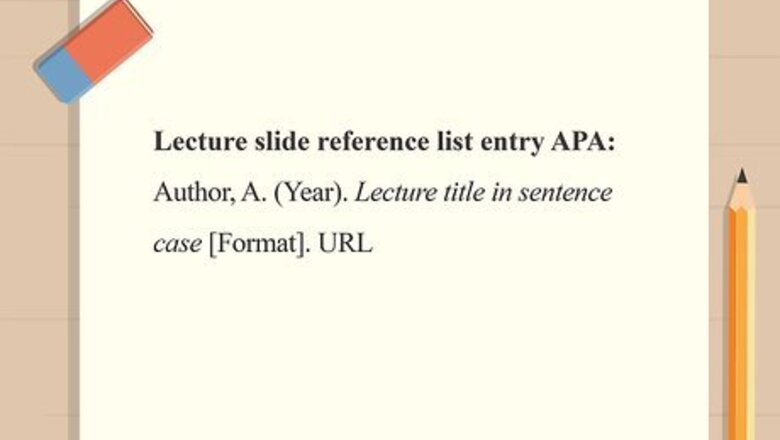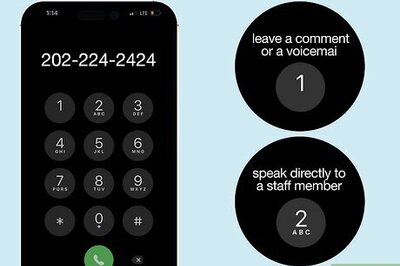
views
X
Trustworthy Source
Purdue Online Writing Lab
Trusted resource for writing and citation guidelines
Go to source
Listing References

Leave out a Reference List entry if the slides aren't published online. The point of your Reference List is to provide your readers with enough information to access the source you used themselves. If the slides aren't openly available to your readers, there's no need for a Reference List entry at all. If you retrieved the slides from a class website, such as Canvas, that requires a password to access, you would normally still include a Reference List entry. A reader could contact the author of the slides for access. If you have a downloaded copy of the slides but they aren't available to the general public, you would still normally cite them as personal communication. Check with your instructor or advisor to see if they would like for you to attach a copy of the slides to your paper as an appendix.
Start your Reference List entry with the author's name. Type the author's (or lecturer's) last name first, followed by a comma. Then type their first initial, followed by a period. If their middle initial is also given, include that after the first initial. Example: McGonagall, M.

Add the year that the slides were created. In APA, the year in your citation, listed in parentheses after the name of the author, is typically the year of publication. In the case of lecture slides, this is the year they were created. However, if you don't have any information for the year the slides were created, simply use the year you saw the presentation. Example: McGonagall, M. (2018).
Provide the title of the presentation and a description of the format. Type the title of the presentation in italics. Use sentence case, capitalizing only the first word and any proper nouns in the title. If the presentation also has a subtitle, place a colon after the title and then type the subtitle in sentence case, making sure to capitalize the first word. Type a space at the end, then type the format of the lecture slides in square brackets. Place a period after the closing brackets. Example: McGonagall, M. (2018). A guide to advanced transfiguration [PowerPoint slides]. If the slides were saved in a different format, use the name of that format. For example, if the lecturer used Apple Keynote, you would list the format as "[Keynote slides]." If the slides were saved in document format, list the format of the document followed by the word "document," such as "[PDF document]" or [Word document]."
Close with the URL where the slides can be found. Type a direct URL that will take your reader to the presentation cited. Do not add a period after the URL. If the presentation was retrieved from a class website, such as Canvas, that you need to be a member of the class to access, use the name of the webpage instead. Website example: McGonagall, M. (2018). A guide to advanced transfiguration [PowerPoint slides]. https://www.hogwarts.edu/transfiguration/slides/chapter_4 Canvas example: McGonagall, M. (2018). A guide to advanced transfiguration [PowerPoint slides]. Retrieved from WebCampus. Reference List Format: Author, A. (Year). Lecture title in sentence case [Format]. URL
Creating In-Text Citations

Add a "personal communication" parenthetical citation for unpublished slides. If the slides weren't published online, you'll only have an in-text citation, not a Reference List entry. Type the author (or lecturer's) first initial and last name, followed by a comma. Then type the words "personal communication," also followed by a comma. Finally, provide the date of the lecture in month-day-year format. For example, you might write: Although people usually consider dark arts the most dangerous, transfiguration has landed more Hogwarts students in the hospital (M. McGonagall, personal communication, May 4, 2018).
Include the author's last name and the year in a standard parenthetical citation. The standard APA in-text citation requires the author's last name and year, separated by a comma, in parentheses. Place this citation at the end of any sentence in which you quote or paraphrase from the source, inside the sentence's closing punctuation. For example, you might write: Transfiguration is not only one of the most difficult and complex skills mastered by Hogwarts students, but also one of the most dangerous (McGonagall, 2018).
Use the year only if you mention the author's name in your text. In some contexts, you might find that your text flows more smoothly if you include the author's name in your text. When you do this, you only need a parenthetical with the year of publication, placed immediately after the author's name. For example, you might write: McGonagall (2018) noted that it would be a mistake not to take the inherent danger in transfiguration seriously.
Provide a slide number for direct quotes. In most lecture slide presentations, the slides are numbered. If they aren't numbered, you'll have to count them. In your parenthetical citation, add a comma after the year of publication, then type the word "slide" followed by the slide number. For example, you might write: Advanced transfiguration spells are attempted only by the top students at Hogwarts (McGonagall, 2018, slide 4).

















Comments
0 comment